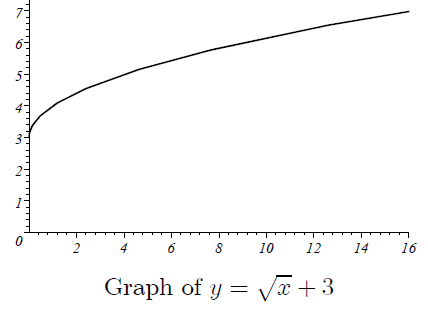VERTICAL TRANSLATIONS OF FUNCTIONS
Subscribe to our ▶️ YouTube channel 🔴 for the latest videos, updates, and tips.
Vertical translations of functions are the transformations that shifts the original graph of the function either up or down.
Definition
A vertical translation "slides" an object a fixed
distance either up or down. The original object and its translation
have the same shape and size, and they
face in the same direction.
In simple words, vertical translation means, it just moves the given figure either up or down without rotating, re sizing or anything else.
Rule


Let y = f(x) be a function and k be a positive number.
In the above function, if y is replaced by 'y - k, we get the new function
y - k = f(x)
or
y = f(x) + k
The graph of y = f(x) + k can be obtained by translating the graph of y = f(x) towards upward by k units.
In case, y is replaced by y + k, we get the new function
y + k = f(x)
or
y = f(x) - k
The graph of y = f(x) - k can be obtained by translating the graph of y = f(x) towards downward by k units.
Moreover, if the the point (x, y) is on the graph of
y = f(x),
then the point (x , y + k) is on the graph
y = f(x) + k
Example :
Perform the following transformation to the function
y = √x
"a translation upward by 3 units"
And also write the formula that gives the requested transformation and draw the graph of both the given function and the transformed function
Answer :
Step 1 :
Because we do a translation towards upward by 3 units, we have to replace y by y - 3 in the given function
y = √x
Step 2 :
So, the formula that gives the requested transformation is
y - 3 = √x
or
y = √x + 3
Step 3 :
The graph y = √x + 3 can be obtained by translating the graph of y = √x toward upward by 3 units.
Step 4 :
The graph of the original function (given function).

Step 5 :
The graph of the transformed function.

Subscribe to our ▶️ YouTube channel 🔴 for the latest videos, updates, and tips.
Kindly mail your feedback to v4formath@gmail.com
We always appreciate your feedback.
About Us | Contact Us | Privacy Policy
©All rights reserved. onlinemath4all.com

Recent Articles
-
90 Degree Clockwise Rotation
Jan 01, 26 06:58 AM
90 Degree Clockwise Rotation - Rule - Examples with step by step explanation -
US Common Core K-12 Curriculum Algebra Solving Systems of Equations
Jan 01, 26 04:51 AM
US Common Core K-12 Curriculum - Algebra : Solving Systems of Linear Equations -
Solving the HARDEST SAT Math Questions ONLY using Desmos
Dec 31, 25 05:53 AM
Solving the HARDEST SAT Math Questions ONLY using Desmos
